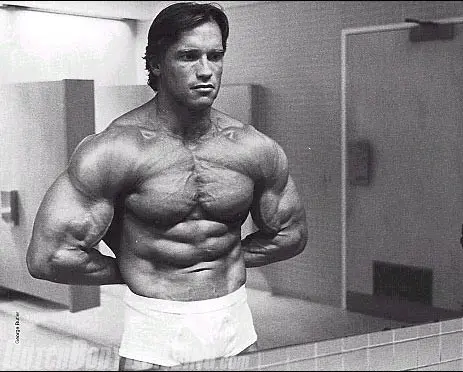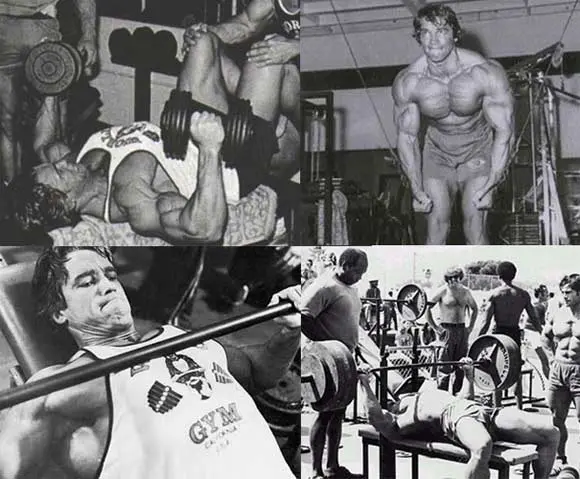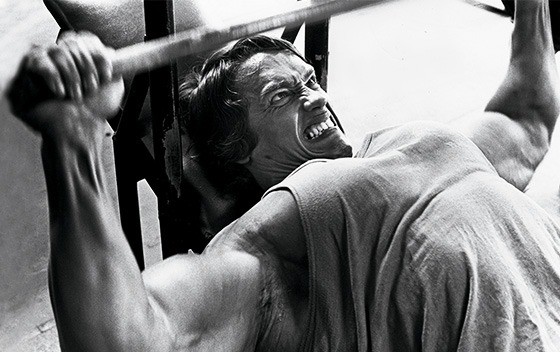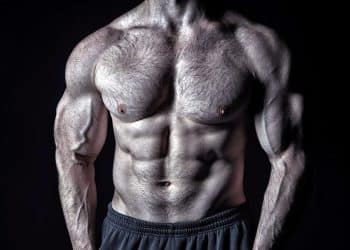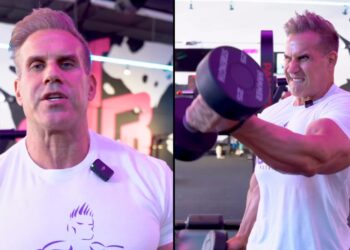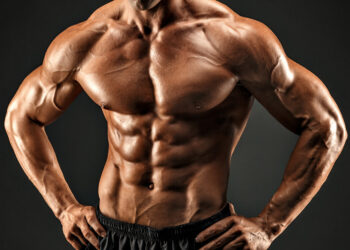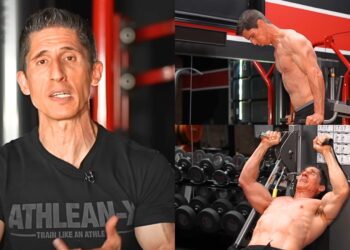At a tape-busting 58”, Arnold Schwarzenegger’s chest was a masterpiece of definition, size and shape. His pecs were so defined that he could crunch them into distinct, bulging masses: upper, lower, left and right. His chest rippled with striations and veins, overlaying a rib cage that made his body seem more like a suit of armor than flesh and bone.
Bodybuilding has changed a lot over the thirty years since Arnold’s heyday. The sport has exploded in popularity, with more people participants and many more watching. It has exploded in another significant way as well: the size of the muscles onstage.
Changes in techniques and new developments in dietary science and supplementation have broken down barriers and made the sport as much a science as it is an art.
Thirty years ago, it would have unthinkable to have a back as broad or thighs as thick as what is possible today. The kinds of bodies we see in competition now were solely in the realm of imagination in those days.
The sweeping magnificence of Arnold’s chest and arms is well known, with pecs that had such a drastic, high arch that in a side chest pose he could balance a glass of water on them. His likeness is plastered on weight room walls and home gyms all over the world. He has been a source of inspiration and motivation to a whole generation of countless competitors and bodybuilding enthusiasts, professional and amateur alike. But how did he build the muscles that won him six consecutive Mr. Olympia titles?
Roots
Arnold developed his workout routine over a number of years, perfecting it and refining it through successes and setbacks. It is important to know how his routine evolved over the years, including what worked for him and what didn’t. There are two distinct stages of Arnold’s career. In the first years of his career, he focused on building mass. While the routine he used at this point was great for this purpose, it would only lay the foundation for the chest that would later win him awards.
Level Up Your Fitness: Join our 💪 strong community in Fitness Volt Newsletter. Get daily inspiration, expert-backed workouts, nutrition tips, the latest in strength sports, and the support you need to reach your goals. Subscribe for free!
Arnold’s goal at this point was getting big. He drew motivation and inspiration from images of Reg Park. Park was frequently featured in the pages of Muscle Builder (the magazine that would later become Muscle and Fitness). Arnold began working toward achieving Park’s size and his thick chest and torso. “He had both a huge rib cage and enormous pectorals, and every time I saw his famous side chest shot, I knew that I wanted to soon be as good in the same pose,” Arnold said later.
Arnold studied Reg Park’s muscle development and concluded that there were three factors that made his chest so superb and well-defined. The size of Park’s muscles was the most obvious factor. The thickness and width of his pecs had never been seen before, and their height gave Park’s torso a tree-trunk appearance.
The balance of his muscle groups was also an important factor. The pectoralis major and pectoralis minor were both well developed. This balance gave Park’s chest a more proportionate appearance, demonstrating that he gave time and attention to inclines as well as flat benches. Had Park focused too much on flat benches, his chest would likely have had a sagging, rounded appearance as opposed to the mighty, squared appearance that he had achieved.
Underneath it all was Park’s vast rib cage. He had the largest rib cage in the industry at the time.
With Park’s image in his mind, Arnold developed a routine that emphasized mass. He packed on nineteen inches of mass with his new routine. Three days a week, he would work hard on his chest, often doing back exercises on the same day. He was a heavy and hard-hitting six-days-on/one day off double-split routine that in five years increased his chest from 39 inches to 58 inches. He would maintain his double-split routine throughout most of his career. With results like that, who wouldn’t?
However, in 1968, Arnold learned one of the most important lessons of his bodybuilding career. He was on his way to having the largest chest ever seen, but without the focus on the definition as well as development, Arnold lost the Mr. Universe competition that year to Frank Zane. Zane wasn’t as big as Arnold was, but his cut and well-sculpted figure won him the title that year. In competitive bodybuilding, definition and mass are equally important, and although he was huge, Arnold’s smooth muscles needed refining. He won the Mr. Olympia competition in both 1970 and 1971. However, when he learned he would be facing Frank Zane along with other major players in 1972, Arnold got to work designing a routine to defend his title.
In his time working with Joe Weider, he had learned about super flushing and supersets. In preparation for the 1972 Mr. Universe competition, he made the revolutionary decision to train his chest and back as one superset, remembering the gains he had made in his earlier days by training his chest and back together.
There were a lot of advantages to training this way. He was able to save a lot of time since alternating chest exercises with back exercises rather than reserving different days for different routines was both faster and more efficient. Working his chest and back as a superset allowed Arnold to push himself to the absolute limit because it enabled him to work with much more weight at once. It also let him hold a greater pump for much more time.
There was also a continuous flushing effect while alternating chest and back exercises. Since each muscle group rested while the other was working, and then was worked again while the other rested, all of his muscles remained flushed for the entirety of the workout. Flushing and pumping his back and chest all at once gave Arnold an experience that he called indescribable as if he could feel his muscles growing with each workout.
The Program
Now that you know the background and the theory, it’s time to learn how all of Arnold’s experience and theory fit together to build his competition busting chest.
Warm-Up/Exercise 1: Barbell Bench Press/Chinning Bar
Arnold’s warm-up involved alternating ever-increasing weights with the barbells and reps at the chinning bar. These came immediately one after the other. He took no rest in between the exercises. Arnold noted that a particularly important aspect of these sets that could easily be overlooked was deliberate, deep breathing. Breathing was a component of all his exercises because, in addition to keeping the blood well-oxygenated, deep breathing helped expand his rib cage. Remember that Reg Park, whose ribcage was at one point the largest in the competitive world, was his role model and the person he strived to emulate.
• Warm-Up: Bench press: 30 to 40 reps with 135 pounds on the barbell
• Chinning bar: 15 wide grips, behind the neck
• Bench press: 20 reps with 225 pounds on the barbell
• Chinning bar: 15 wide grips, behind the neck
• Bench press: 15 reps with 275 pounds on the barbell
• Chinning bar: repeat
• Bench press: 12 reps with 315 on the barbell
• Chinning bar: repeat
• Bench press: 8 reps with 365 on the barbell
• Chinning bar: repeat
• Bench press: 6 reps with 405 on the barbell
• Chinning bar: repeat
Exercise 2: Incline Barbell Presses
Remember that Arnold realized that to keep a balanced appearance, he had to work both his lower and upper pectorals. The incline barbell press works to build the upper pecs. Many people neglect to include this in their routines, but doing so keeps the chest looking squared and proportional.
Just as he took no rests when alternating the bench press and chinning bar, he took no break after finishing those sets and began the incline barbell press immediately. He alternated each incline barbell press set with T-bar rows. With each set on the barbell, he would add 20 pounds. The sequence went:
• Incline press: 15 reps with 225 pounds T-bar rows
• Incline press: 12 reps with 245 pounds
• T-bar rows
• Incline press: 12 reps with 265 pounds
• T-bar rows
• Incline press: 10 reps with 285 pounds
• T-bar rows
• Incline press: 10 reps with 305 pounds
• T-bar rows
Exercise 3: Flat Dumbbell Flyes
This exercise involves a difficult movement that Arnold best summed up as using a tree-hugging motion. When this technique is mastered, it can further sculpt the outer pecs and also help expand the rib cage. Along with being technically difficult, Arnold made sure to control his breathing in order to use the rib-expanding potential to its fullest.
To do this exercise, he would lie flat with his arms bent slightly. Before he lowered the dumbbells, he would take a deep breath. Then he would lower the dumbbells, taking them away from his torso and out. It’s best to get the dumbbells as low to the floor as you possibly can – Arnold would get them so low that they almost touched the floor. Then he pushed his breath out, exhaling continuously as he brought the dumbbells back up. To get the most out of this exercise, he would flex his pecs the entire time when bringing the dumbbells back through the range of motion to the starting position.
Arnold’s form during this exercise was of paramount importance. In order to avoid wasted time and energy, when the dumbbells came to the top of the arc, Arnold would stop and hold the dumbbells in the air, about a foot apart from each other. This is because as he came closer to end of the movement, the strain on his chest would taper off and have no effect on his muscles. To expend the energy to go any further would be a waste and take up valuable time that he could be spending on something more productive.
At this point, he would begin the first part of the motion again, bringing the dumbbells back down to the floor. Arnold used the Weider Peak Contraction Training principle and squeezed his pecs very hard before lowering the weights.
Level Up Your Fitness: Join our 💪 strong community in Fitness Volt Newsletter. Get daily inspiration, expert-backed workouts, nutrition tips, the latest in strength sports, and the support you need to reach your goals. Subscribe for free!
All the mindful components of this exercise – the controlled breathing, squeezing his pecs at specific points in the movement, using a controlled range of motion – were what helped Arnold use this difficult but rewarding exercise to its fullest potential. The dumbbell flyes were the superset with barbell rows, which Arnold performed on a block so he could extend the exercise’s range of motion. The flat dumbbell flyes sequence he used was:
• Dumbbell flyes: 15 reps with 65 pounds
• Barbell rows
• Dumbbell flyes: 12 reps with 75 pounds
• Barbell rows
• Dumbbell flyes: 10 reps with 85 pounds
• Barbell rows
• Dumbbell flyes: 10 reps with 85 pounds
• Barbell rows
• Dumbbell flyes: 10 reps with 85 pounds
• Barbell rows
Exercise 4: Parallel Bar Dips
Arnold performed this exercise to sculpt the bottom of his pectoralis major muscles into a neat, clean line. He felt that this exercise was the best for doing this.
He did this exercise with an 80-pound dumbbell attached to his waist. At the bars, he would lower his body down so that his hands were almost level with his armpits. He controlled his breathing during this entire exercise so that he was inhaling on the way down. Pushing himself back up rapidly and powerfully, he would exhale. This exercise was excellent for filling the muscles with blood, and Arnold said that by the time he finished the last set his muscles were so pumped that they felt ready to explode from his skin!
The parallel bar dips were the superset with close grip chin ups. Arnold did five sets of 15 parallel bar dips and five sets of close grip chin ups.
Exercise 5: Stiff Arm Pullovers
At this point in his workout routine, Arnold was finished with his chest-back supersets. To round out the lifting segment of his workout, Arnold included pullovers. He felt that pullovers were the key factor in expanding his rib cage to such huge proportions. Pullovers stretched his pectorals, latissimus dorsi and rib cage all at once – truly a hard hitter. By this point in his routine, Arnold was exhausted but didn’t let fatigue stop him from completing his workout.
To perform the exercise, he would lie over a flat bench. He would extend a medium (relative to his strength, of course! Arnold used a 90-pound weight for this exercise) weight out to almost arms’ length, keeping his arms slightly bent. He would then lower the weight down below his head, moving it in an arc. Always mindful of getting the greatest impact possible out of his exercises, he would keep his hips flat against the bench. This allowed his muscles to stretch as far as they could. He would also keep his breathing controlled, inhaling through his mouth, getting a lungful of air each time. He did this exercise five times with 15 to 20 reps in each set. Between sets, he would take about 30 seconds to walk around, taking deep breaths to stretch his chest as far as it could possibly go.
Arnold would later say the ache from this exercise was incredible. The sternum was pulled apart by the range of motion in this exercise, forcing new growth.
Exercise 6: Iso-Tension Contractions
Arnold would finally finish up his grueling routine with an intense bout of flexing. He would first hit the side chest pose from both sides, expanding his rib cage to its fullest. Then, to bring the muscles to their fullest and highest, he would squeeze his pecs as hard as possible, crimping them as well. This brought out veins and striations in the muscle tissue to the surface and helped him gain greater control of each muscle group.
Rewards
Arnold’s routine lasted about an hour, and after he was finished he was exhausted, breathing heavily and covered in sweat. He was in pain, his muscles pumped but aching. Arnold loved every moment of it, feeling exhilarated, like a boxer who had come out of a 15-round fight with a heavyweight champion. And in another two days, he would get to feel it all over again.
It was an unbelievably harsh and demanding routine, but for Arnold, the rewards were unarguable. Arnold insisted that his routine helped expand his rib cage, despite little scientific evidence that this is possible. The pain and exhaustion from this workout was just a side effect of the process of sculpting and shaping the “World’s Greatest Chest.” This routine got him to his apex Mr. Olympia form in the early 1970s. However, this routine may be too rigorous for most bodybuilders.
Arnold’s Chest-Back Workout:
• Warm-Up: Bench press, 1 set, 30-45 reps
• Exercise 1: Bench press, 5 sets, 6 reps, superset with Wide-grip behind-the-neck chin ups, 5 sets, 15 reps
• Exercise 2: Incline barbell press, 5 set, 10-15 reps, superset with T-bar rows, 5 sets, 10-15 reps
• Exercise 3: Flat bench dumbbell flyes, 5 sets, 10-15 reps, superset with Wide grip barbell rows, 5 sets, 10-15 reps
• Exercise 4: Parallel bar dips, 5 sets, 15 reps, superset with Close grip chin ups, 5 sets, 12 reps
• Exercise 5: Stiff arm pullovers, 5 sets, 15-20 reps
• Exercise 6: Iso-tension contractions, finishing.
Arnold did all these exercises in one session with no breaks in between sets.
The Double Split Routine
The double split is a routine that was trendy during Arnold’s heyday but has not been popular for a few decades. Double-split routines involve splitting the muscles of the body into different groups that are worked in separate workouts. Two workouts are performed per day. People would usually do one workout in the morning and one in the evening. Some of the more extreme athletes like Roy Callendar, however, would stay in the gym doing all-out workouts for eight hours.
True double splits are rare these days, with most athletes and bodybuilders using a somewhat-less rigorous split program. In fact, a true double-split routine is now regarded by most people as too rigorous and leading to overtraining. However, as rare as it is today, the double split was the rule in the 1970s.
Arnold’s routine was a two-day split, with six days working out and one day off. The two-day split resulted in Arnold’s entire body being trained within two days, which he would repeat three times during his six days working out.
Arnold’s routine was:
• Day One: Chest and back in the morning, thighs, calves and abs in the evening.
• Day Two: Shoulders and arms in the morning, calves and abs in the evening.
• Day Three: Repeat Day One.
• Day Four: Repeat Day Two.
• Day Five: Repeat Day One.
• Day Six: Repeat Day Two.
• Day Seven: Rest.
As you can see, Arnold’s double split routine was extensive, which probably contributed to its falling out of favor in more recent years. The time and energy requirements alone are too much for many bodybuilders, who often have other obligations to fulfill.
Use Caution
Arnold’s routine is safest for bodybuilders who are at a more advanced level of experience. It’s possible to pass out, vomit and experience other symptoms of exhaustion and overtraining while doing this routine, and even experienced bodybuilders can have this happen to them. Less-advanced bodybuilders can and should alter the progression of the program if they are interested in using it. Performing fewer supersets of each routine and using less weight when first starting out is a good idea. Adding rest breaks in between supersets is also a good idea since it will allow you to move more weight for a longer period of time. As you become more advanced, you can increase the weight and number of supersets until you get to the five that Arnold performed. You may even be able to decrease your resting time as you advance until you can do the whole routine in one long session with no rest between supersets.




